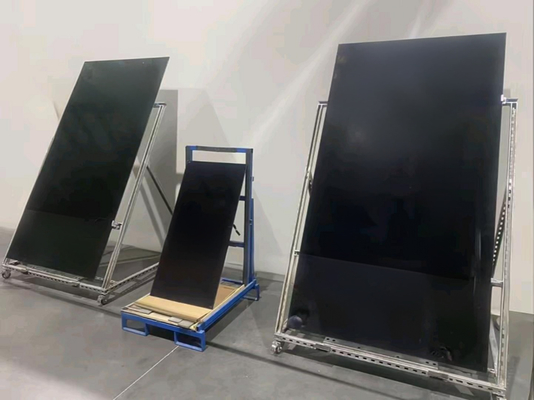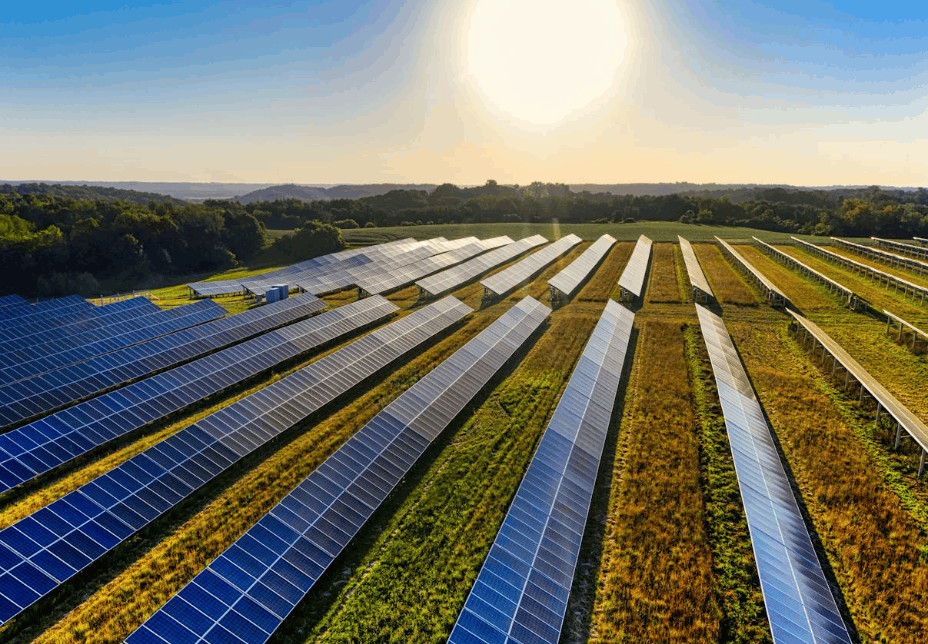445W CdTe Solar Glass - Architectural BIPV Panel
Advanced Building-Integrated Photovoltaic Solution
This frameless solar glass panel combines high-efficiency CdTe technology with architectural functionality, delivering 445W peak power in a sleek, black format. Designed for seamless building integration, it offers superior temperature performance and excellent low-light response, making it ideal for commercial facades and curtain wall systems.
Key Advantages
-
Superior Efficiency: CdTe technology outperforms silicon in real-world conditions
*CdTe semiconductors have a higher absorption coefficient than crystalline silicon, enabling better performance in diffuse light and high-temperature environments. This results in up to 10% higher energy yield in real-world conditions compared to conventional panels.*
-
Architectural Quality: Frameless design with uniform black appearance
The completely frameless construction with 0% light transmittance creates a seamless, uniform black surface that integrates perfectly with modern architectural designs. This eliminates visible mounting frames and silver grid lines, maintaining aesthetic integrity while providing weather protection and power generation.
-
Proven Reliability: -0.214%/°C temperature coefficient ensures stable performance
*With a power temperature coefficient of just -0.214%/°C, this panel maintains significantly better performance at elevated temperatures compared to conventional silicon panels (-0.45%/°C typical). This makes it particularly suitable for hot climates and building-integrated applications where operating temperatures often exceed standard test conditions.*
Technical Features
1. Advanced Cell Technology
-
Cadmium Telluride semiconductors
*CdTe technology offers several advantages over conventional silicon, including better spectral response in real-world light conditions and superior performance in diffuse light. The thin-film construction also uses 98% less semiconductor material than conventional silicon cells, reducing the carbon footprint of manufacturing.*
-
Thin-film construction
At just 9.7mm thick, the panel maintains the profile of conventional architectural glass while incorporating robust photovoltaic functionality. The tempered glass construction meets ANSI Z97.1 and EN 12600 safety standards for architectural glazing applications.
2. Electrical Performance
-
184V open circuit voltage
*The high voltage output allows for longer string lengths and reduced balance-of-system costs. For large commercial installations, this can reduce the number of combiner boxes and conductors required, lowering overall system cost by up to 15%.*
-
3.08A operating current
Lower operating current reduces resistive losses in the DC cabling and enables the use of smaller gauge wiring. This is particularly beneficial in building-integrated applications where cable routing space is often limited.
3. Mechanical Design
-
9.7mm tempered glass
*The heat-strengthened tempered glass construction provides exceptional durability and impact resistance. The panel meets IEC 61215 and IEC 61730 standards for mechanical load testing, capable of withstanding 5400Pa wind loads and 2400Pa snow loads.*
-
Frameless construction
The completely frameless design enables true seamless integration with curtain wall systems and architectural glazing. The edge-to-edge active area maximizes power generation per square meter while maintaining a clean, modern appearance.
Technical Specifications
|
Parameter
|
Value |
Unit |
|
Electrical Characteristics
|
|
|
|
Peak Power (Pmax)
|
445 |
W |
|
Open Circuit Voltage (Voc)
|
184.0 |
V |
|
Short Circuit Current (Isc)
|
3.50 |
A |
|
Maximum Power Voltage (Vmp)
|
144.5 |
V |
|
Maximum Power Current (Imp)
|
3.08 |
A |
|
Mechanical Specifications
|
|
|
|
Dimensions
|
1215×2300 |
mm |
|
Thickness
|
9.7 |
mm |
|
Weight
|
62 |
kg |
|
Temperature Coefficients
|
|
|
|
Power Temperature Coefficient
|
-0.214 |
%/°C |
|
Voltage Temperature Coefficient
|
-0.321 |
%/°C |
|
Current Temperature Coefficient
|
+0.06 |
%/°C |
|
System Ratings
|
|
|
|
Maximum System Voltage
|
1500 |
V |
|
Fuse Rating
|
6.0 |
A |
|
Optical Properties
|
|
|
|
Light Transmittance
|
0% |
- |
|
Surface Color
|
Black |
- |
Applications
● Building Facades
-
Commercial curtain walls
Ideal for replacing conventional spandrel glass in curtain wall systems, providing both building envelope protection and renewable energy generation. The black appearance blends seamlessly with modern architectural designs while generating electricity from the building facade.
-
Architectural features
Can be incorporated into various architectural elements including canopies, shading devices, and decorative features. The uniform black appearance maintains design consistency while adding functional energy generation capability.
● Specialized Structures
-
Parking canopies
Provides both weather protection and power generation in a single system. The high voltage output reduces wiring costs for large parking structures, while the excellent temperature performance maintains output even in hot summer conditions.
-
Noise barriers
Dual-function design for highway and infrastructure applications provides both acoustic attenuation and renewable energy generation. The robust construction withstands environmental exposure while generating electricity from otherwise unused space.
FAQ
Q: How does temperature affect performance?
*A: With -0.214%/°C power coefficient, it maintains significantly better performance at elevated temperatures compared to silicon panels (-0.45%/°C typical). At 65°C operating temperature, CdTe panels typically show only 15% power reduction compared to 25%+ for conventional silicon.*
Q: What mounting systems are compatible?
A: Designed for both structural glazing systems and conventional mounting methods. The frameless design allows for point fixing or perimeter framing, with appropriate thermal expansion accommodation. Specialized mounting hardware is available for various architectural applications.
Q: What warranty is provided?
*A: 25-year linear power output warranty with 90% performance guarantee at 10 years and 80% at 25 years. The product warranty includes 3-year materials and workmanship coverage, with optional extended warranty available for commercial projects.*
Installation Notes
⚠ Structural Requirements
-
Verify load capacity for 62kg panel weight - requires structural analysis by qualified engineer to ensure building can support additional dead load
-
Account for thermal expansion in mounting design - aluminum framing systems must accommodate ±3mm thermal movement
-
Follow electrical safety standards for 1500V systems - requires UL-certified components and proper grounding systems
⚠ Environmental Considerations
-
Maintain clearance for thermal management - minimum 10mm air gap behind panels for proper ventilation
-
Ensure proper drainage to prevent water accumulation - mounting system must allow for water drainage and prevent moisture entrapment

 Your message must be between 20-3,000 characters!
Your message must be between 20-3,000 characters! Please check your E-mail!
Please check your E-mail!  Your message must be between 20-3,000 characters!
Your message must be between 20-3,000 characters! Please check your E-mail!
Please check your E-mail! 









